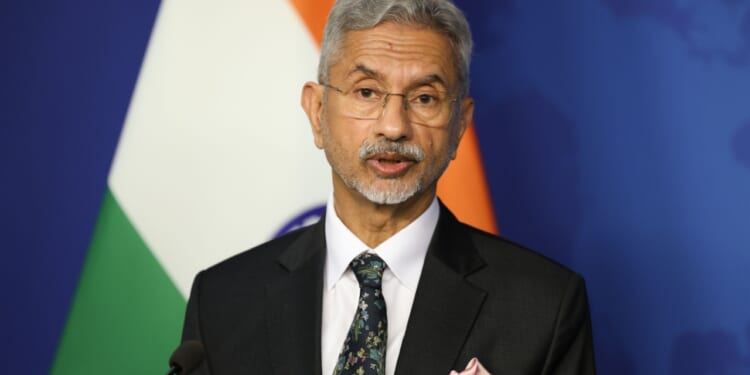Afghanistan’s break with Pakistan has created a strategic window for India.
Afghanistan’s trade and diplomacy are shifting in unexpected ways that reflect broader regional realignments. Four years after India shut its Kabul embassy following the Taliban’s return, bilateral trade has nearly rebounded to pre-2021 levels—even as Afghanistan’s trade through Pakistan collapses. This reversal highlights Pakistan’s waning leverage and India’s quiet re-emergence as a key economic and diplomatic player, a trend that increasingly links Afghanistan’s revival to India’s wider westward strategic turn, with Kabul serving as New Delhi’s gateway to Central Asia.
The Revival of Afghan-Indian Trade
Before 2021, India–Afghanistan trade reached $1.33 billion, with India exporting $826 million and importing $509 million in Afghan goods. After the Taliban takeover, India’s exports plunged to $437 million in 2022–23. But by FY 2023–24, trade surged back to $997.7 million, driven by Afghan exports of dried fruits, saffron, nuts, and apples—now duty-free in India. Afghan exports reached a record $642 million, resulting in India’s first trade deficit with Kabul.
Between April 2024 and March 2025 alone, trade reached $1 billion, signaling full recovery by year’s end. Both sides are exploring Iran’s Chabahar Port, developed by India, as a means to bypass Pakistan. India also plans to reopen its Kabul embassy and expand direct flights, reflecting what Dr. Shanthie Mariet D’Souza calls a shift from “cautious engagement” to reconnecting and rebuilding ties.
Afghanistan’s Breakdown With Pakistan
While ties with India deepen, Afghanistan’s trade with Pakistan—once its economic lifeline—is collapsing. Transit trade through Pakistan dropped from $7 billion in 2022 to $2.9 billion in 2024, an almost 60 percent fall, due to Islamabad’s anti-smuggling drives, tighter customs, and frequent border closures amid rising border clashes.
Though direct bilateral trade rose modestly, Pakistan’s role as a transit hub has eroded. The decline mirrors political tensions: Islamabad accuses Kabul of harboring TTP militants, while Kabul denies it. On October 9, Pakistan launched an unprecedented airstrike on Kabul, coinciding with Taliban foreign minister Amir Khan Muttaqi’s visit to New Delhi—an unmistakable signal of shifting loyalties.
A New Regional Balance
India’s outreach to the Taliban reflects strategic pragmatism amid Russia’s recognition of the regime, China’s growing role, and Pakistan–Afghanistan tensions. New Delhi aims to regain influence lost in 2021 and prevent Afghanistan from tilting fully toward Beijing or Islamabad. For the Taliban, India offers investment and a counterweight to Pakistan. Afghanistan’s potential in minerals, horticulture, and agriculture, as Dr. D’Souza notes, presents lucrative opportunities for Indian firms.
Both sides also share an interest in regional connectivity—“Afghanistan is crucial as a land bridge for India in terms of connectivity to Central Asia,” she emphasizes. India’s growing investment in the Chabahar Port and overland corridors through Afghanistan underscores a broader realignment—one in which India is turning decisively westward to find strategic depth beyond encirclement.
India Turns Westward To Escape Encirclement
India’s renewed engagement with Afghanistan is also driven by an urgent reality – encirclement by China’s expanding influence. Pro-Chinese governments have taken hold in Bangladesh, Sri Lanka, the Maldives, and, until September, Nepal, eroding India’s traditional sway, while Pakistan remains firmly aligned with China. According to Vlad Paddack, New Delhi is recalibrating its approach, looking westward to seek out new partnerships.
This logic echoes the ancient Rajamandala (“circle of kings”) theory of Indian strategist Chanakya, which holds that a neighbor’s neighbor is a natural ally against immediate adversaries. As its neighborhood tilts toward Beijing, India is seeking partnerships with Afghanistan, Iran, and Central Asia to form concentric alliances that balance Chinese and Pakistani influence and reassert India’s role in the emerging Eurasian order.
Iran’s Chabahar Anchor
Iran’s Chabahar port remains the cornerstone of India’s westward strategy—a sanctions-exempt, India-run port that anchors regional trade while bypassing Pakistan. Under a 10-year deal signed in May 2024 and integrated with the International North–South Transport Corridor (INSTC), Chabahar has the potential to handle 8.5 million tons of cargo, making it a vital artery for Indian exports of pharmaceuticals, machinery, and vehicles to Eurasia.
The port also serves as Afghanistan and Central Asia’s access point to the Arabian Sea. India is investing $120 million in upgrades and offering a $250 million credit line to expand capacity, while Taliban officials declared a $35 million investment in the port. Despite competition from China’s Gwadar Port, Chabahar endures as India’s most reliable maritime lifeline and a crucial pillar of its westward realignment.
Afghanistan As India’s Gateway To Central Asia
Afghanistan lies at the heart of India’s westward strategy. Through overland corridors via Herat and Turkmenistan, India can bypass Pakistan and gain direct access to Central Asia. The region’s transport map now revolves around two rival routes: the eastern Uzbekistan-Afghanistan-Pakistan (UAP) railway tied to the China-Pakistan Economic Corridor (CPEC), and a western Kazakhstan-Turkmenistan-Afghanistan (KTA) route favored by India.
India’s challenge is that the UAP could cut transit time from 35 days to five, boosting Pakistan’s growing export base. India risks losing ground if eastern routes dominate. For India, KTA serves as both a hedge and a necessity, ensuring reliable connectivity to Central Asia that is free from Pakistani or Chinese control.
Ultimately, India’s engagement with Afghanistan—as a trading partner and transit ally—represents more than a tactical adjustment. It signals a larger strategic repositioning: encircled by China’s influence, India is turning westward through Afghanistan and Iran, reviving the logic of Chanakya’s “circle of kings” to craft concentric partnerships that balance Chinese and Pakistani influence, thereby reasserting India’s role in the evolving Eurasian order.
About the Authors: Vlad Paddack and Eldaniz Gusseinov
Vlad Paddack is a Fellow at Nightingale Int. and Senior Analyst at AKE International, specializing in Eurasian security and political affairs, with a particular focus on the intersection of energy and geopolitics. He completed his undergraduate studies at the Department of War Studies, King’s College London. He earned his master’s degree at the Graduate Institute of Geneva, where he wrote his thesis on energy security in Kazakhstan and Georgia.
Eldaniz Gusseinov is a geopolitical analyst and Head of Research at Nightingale Int., who focuses on trade corridors, energy transitions, and the strategic behavior of middle powers across Eurasia. Eldaniz has worked for several academic institutions and think tanks in Europe and Central Asia. He has authored and edited multiple analytical papers on regional integration, transport infrastructure, and critical minerals policy, shaping debates on Central Asia’s evolving place in global geopolitics.
Image: Alexandros Michailidis / Shutterstock.com.

















